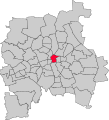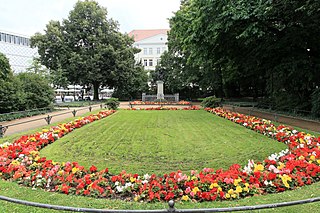
Goerdelerring is a street and major tram interchange station in Leipzig, Germany. It is named after Carl Friedrich Goerdeler.

The Augustusplatz is a square located at the east end of the city centre of Leipzig, borough Leipzig-Mitte. It is the city's largest square and one of the largest squares in Europe. It is also part of the city's inner-city ring-road and a central hub for its tram network.
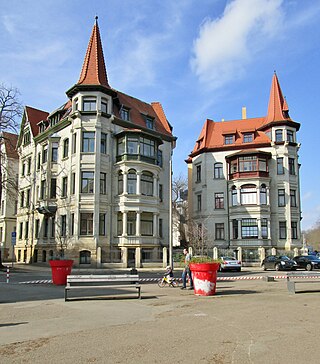
Waldstraßenviertel, is a neighbourhood in the north west of Leipzig's borough Mitte in Saxony, Germany. It is considered one of the largest complete areas of Gründerzeit buildings in Europe and is therefore considered of important cultural and heritage status. Many of its buildings are therefore protected or listed.
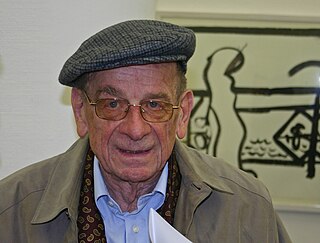
Dieter Goltzsche is a German painter and graphic designer. He won the Hans-Theo-Richter-Preis of the Sächsische Akademie der Künste in 2010.

The Alte Handelsbörse or Alte Börse in Leipzig, Saxony, Germany, is the city's oldest assembly building of merchants, and also the oldest Baroque building. Built as the Börse in 1678, it is now used as an event venue and is known in English as the Old Stock Exchange.

Alte Messe Leipzig is the circa 50 hectares site in the southeastern part of Leipzig's district Mitte, where from 1920 until 1991 the technical exhibitions of the Leipzig Trade Fair took place, as well as the buildings that stand on it – but not the trade fair itself, which found a new home at a new site in the northern part of Leipzig. Since 1996 there has been no trade fair activity on the old site.

The Old Town Hall, which dominates the east side of the Markt square in Leipzig's district Mitte, is considered one of Germany's most important secular Renaissance buildings. At the rear is the Naschmarkt. The mayor and the municipal administration have been housed in the New Town Hall since 1905.
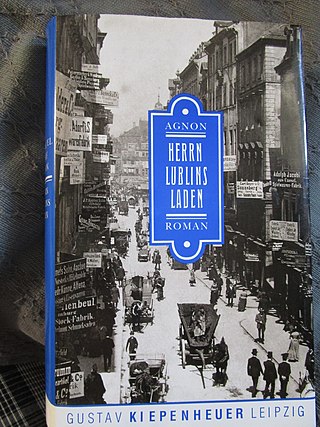
In Mr. Lublin's Store is a novel by the Israeli author Shmuel Yosef Agnon. He describes the thoughts of a first-person narrator who arrived in Leipzig in 1915 about judaism, his unnamed hometown in Galicia and his reception in Leipzig, while he is waiting for the return of his host Arno (Aharon) Lublin in his store in the city centre, located in a narrow alleyway named Böttchergäßchen.

The Inner City Ring Road in Leipzig in the district of Mitte is the ring road around Leipzig's city centre. It encloses the just 0.7 km2 large area of the old town without the former Vorstadts.

The Promenadenring Leipzig is the oldest municipal landscape park in Germany and one of the most important garden and cultural monuments in the city. The term is also used as a synonym for Leipzig's inner city ring road, a traffic facility that is connected to the green spaces of the Promenadenring. Like the inner city ring road, the promenade ring is about 3.6 kilometers long (2.24 mi.).

The Johannapark is an 11 hectares park near the city center in Leipzig. In the southwest it merges seamlessly into the Clara Zetkin Park and together with it and the Palmengarten forms a large park landscape that continues in the north and south in the Leipzig Auenwald.

The Wintergartenhochhaus is a 32-story high-rise building in Leipzig-Mitte, subdivision Ostvorstadt. The residential building was built from 1970 to 1972 as Wohnhochhaus Wintergartenstraße and is the third tallest high-rise in Leipzig after the City-Hochhaus and the Hotel The Westin. With a total height of 106.8 m (350 ft) and 95.5 m (313 ft) roof height, it was the tallest residential building in the East Germany and is now in the top hundred on the list of high-rise buildings in Germany. As a building of modernity and testimony of East German architectural history with rarity value, it is under cultural heritage protection.

Petersstrasse is one of the oldest streets in Leipzig's district of Mitte. For centuries it was a main and commercial street for the Leipzig trade fair with exhibition houses, inns and shops. In the second half of the 19th century, many of the old buildings on the street fell victim to the modernization of the city center. Today it is a heavily frequented pedestrian zone in a prime location with shopping centers, department stores, shops, restaurants and cinemas.

The Markt is a square of about 1 ha in Leipzig's district of Mitte, Germany. It is considered the center of the city. The Old Town Hall stands on it, which demonstrates its particular historical importance. The square was named Platz des Friedens from 1950 to 1954. Its paving is a listed heritage monument.
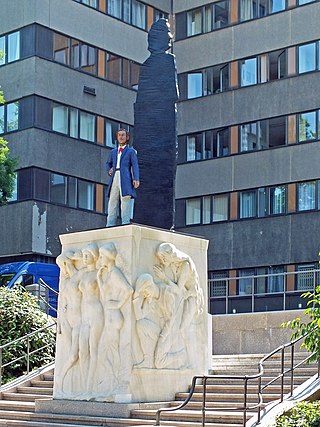
The Richard Wagner Memorial in Leipzig was unveiled in 2013 to mark the 200th birthday of Richard Wagner (1813-1883). It was created by Stephan Balkenhol using the base designed 100 years ago by Max Klinger (1857-1920).

Barthels Hof is a former trade court building complex in Leipzig in Germany, located in the borough Mitte. It is the last “through courtyard” that was preserved almost in its original condition. That means, the carts drove in, the goods were unloaded, and the carts drove out - without turning around. The horses were stabled in the suburbs. Later, from 1893 on, only samples of the goods were shown in the trade fairs and made to order. The Barthels Hof stretches from the market square to Kleine Fleischergasse and is now one of the city's most important sights. Today, it is used for a restaurant and some small shops.

Grimmaische Strasse is a street in Leipzig, borough Leipzig-Mitte, and connects the marketplace with Augustusplatz. It was named in 1839 after the Grimmaischer Tor, the gateway to Grimma, which was first mentioned in 1421. Before that it was called Grimmaische Gasse and was the main street of the Grimma quarter. Today it is a heavily frequented pedestrian zone in a prime location with department stores, shops, restaurants, hotels, a museum and the university as residents.

The St. Nicholas Church Square is a square in the city center of Leipzig, Germany. The St. Nicholas Church stands on it. The church and square have particular significance for the Peaceful Revolution of 1989.





